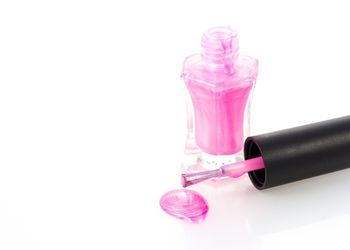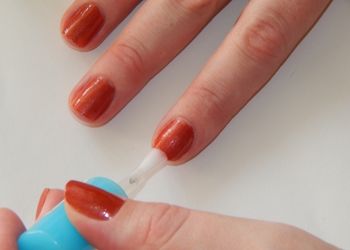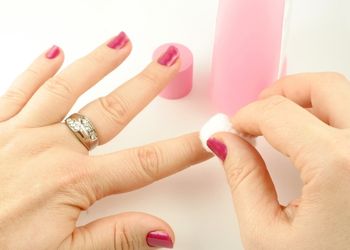Nail polish is a common beauty product for people all over the world. Countless bottles are sold in stores and used in nail salons as we express ourselves with a little color or fun design. But, could this liquid polish become a fire risk? Is nail polish flammable and what do we need to watch out for?

Nail polish can be flammable in its liquid state. There isn’t too much of a risk with small amounts, especially when tightly closed in those glass bottles. But, the acetate in the liquid is a fire risk when exposed to a fire source. Liquid and vapors are an issue. Dry nail polish is safe. In addition to this acetate risk, there is also the issue of acetone in nail polish remover.
The potential risks of nail polish causing fires all come down to chemistry and the physical states of the material. So, it is important to consider the following if you paint your nails a lot.
- The chemical make-up of nail polish
- The way that polish changes state and the effect on flammability
- The risk of having a collection of nail polish at home
- Potential alternative products that are safer to use
- The risk of using nail polish remover
- Fire safety when painting and removing nail polish
Table of Contents
What is nail polish made from?
To better understand the risks of nail polish, we have to take a closer look at its composition and how it reacts.
Whether we call it nail polish or polish, we are talking about the same sort of chemical liquid with some strong solvents and the potential to cure into a solid layer of color.
The color comes from the polymers and pigments within, but the liquid is usually either ethyl acetate or butyl acetate. We apply this as a liquid and wait for the liquid to dry before the nails are set.
Why is nail polish flammable in a liquid state?
It is the liquid form of nail polish that is the problem here. The solvents are the flammable element and if they were to come into contact with open flames then there would be a greater fire risk.
This isn’t that likely when dealing with a small secure bottle of polish at home, but it is important to appreciate the flammable nature of even a drop of nail polish in its liquid state.
Why is nail polish safer in a solid state?
The good news is that you don’t get the same sort of fire hazard when dealing with dry nail polish. This is a relief considering the amount of time many of us will have this coating on our fingers and go on to use other flammable materials or light candles or lighters.

The reason for this is that the dangerous acetate substance in nail polish is only present in the product’s liquid state. The solvents evaporate during the drying process to leave the polymers and color behind, allowing for that nice dry plasticky feel.
This process adds to the fire risks when painting nails, as you are dealing with flammable vapors in the air as well as the solvents in the liquid.
There is probably a greater risk here than with the liquid alone because the vapors can travel close to open flames, whereas the liquid is contained in the bottle.
How do fires start when doing your nails at home?
It is difficult to know just how many fires start due to a reaction between a lit object and nail polish. It is possible that some house fires began this way and the cause wasn’t reported.
But, there are stories out there of people dealing with small incidents of sparks and flames during the nail painting process.
These tend to relate to the vapor from the evaporating acetate rather than the liquid polish. They have ignited when people painted their nails too close to a lit candle or when people were smoking cigarettes while painting their nails.
So, the problem comes more from the proximity of lit objects and open flames than the polish itself.
Is it dangerous to have a lot of nail polish at home?
You may read about all of this and worry that your collection of nail polish at home is now a big fire risk.
There is very little to worry about when it comes to keeping nail polish and building up a good collection. Because the biggest risk comes from the vapors, there isn’t too much of a problem with a sealed bottle.

As long as all the lids are on tight and the bottles are stored away from other flammable products, you should be fine.
The liquid could burn easily in a fire, but by that point, the fire would also have to be intense enough to shatter the glass bottle.
Should I still use nail polish or try something else?
You may read this and decide that you would rather not have acetate nail polish and want a different approach when it comes to painting your nails.
That is understandable if you paint your nails regularly and don’t want to have to be careful with your candles and other risk factors. There is also the fact that you could end up with a more gentle formula where you aren’t breathing in so many fumes.
There are alternatives out there that could be safer in various ways. You just need to be sure that you’ll get the same effect and coverage.
Your first option here is to try a product with an acetate-free formula. These nail polishes are becoming increasingly popular for natural health and beauty regimes, as consumers try and turn away from damaging chemicals.
The idea here is that there are none of the same intense solvents that could weaken the nails or cause other problems. The fact that the solution could be less flammable as a result is just a bonus. It is worthwhile comparing products and ingredients lists to see what you can get.
Another common alternative for nail color is the press-on nail. These products are popular because they are so quick and simple.
You don’t need to be good at painting color onto your nails and you can get a longer length at the same time.
However, this isn’t a good idea if you are looking to remove fire risks.
For a start, these nails are typically made from acrylic, which can burn and melt pretty easily in contact with an open flame.
This means you are walking around with a flammable item on your fingers whereas the nail polish is safe once dry. There is also the issue of the adhesive sticking the nails in place.
Press-on nails are certainly convenient but not safer.
Is nail polish remover flammable?
When talking about the potential fire risks when painting our nails, we also need to talk about nail polish remover. Nail polish remover is another solvent with chemical ingredients. This time the main component is acetone.
This strong chemical can accelerate a fire due to its flammable nature when spilled. Also, the vapors from the solution can have a similar effect as those evaporating from the nail polish.
In fact, there is the possibility that the fires reported from people painting their nails could have been due to the remover if this was open and in use at the time.

There is a lot to consider when using the best nail polish remover and avoiding fire risks. It can be more convenient and potentially safer to have nail polish remover pads rather than a bottle of liquid because of the risks of spilling and storing larger bottles of the solution.
Still, an acetone-soaked cotton pad could burn fairly well if discarded carelessly. A better option could be to go for an acetone-free product, even if it isn’t quite as efficient.
There aren’t too many concerns about painting your nails at home as long as you are careful about where you work and the products used.
Nail salons are at high risk because of the quantity of products stored in the building, the amount of acetone on-site, and other factors like electronic fires. Nail salon fires aren’t that uncommon and there are reports of blazes starting in storage areas and from heat lamps.
Some cases are unexplained and suspected arson. Either way, the amount of acetate and acetone in the salon would have helped accelerate the fire.
There are risk factors to be aware of here when working with liquid nail polish and nail polish remover. A long as you don’t work around any naked flames you should be fine, especially if you only have small bottles of polish.
You can lower the risk by switching to an acetate-free solution if you prefer and using acetone-free remover pads rather than bottles of acetone remover. Just make sure to be aware of where you leave your products, to close them up properly, and to dispose of waste properly.